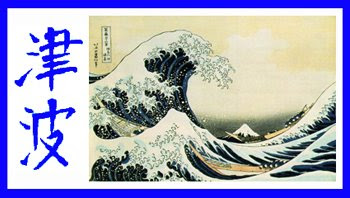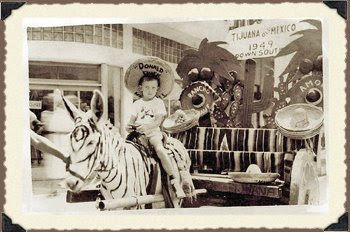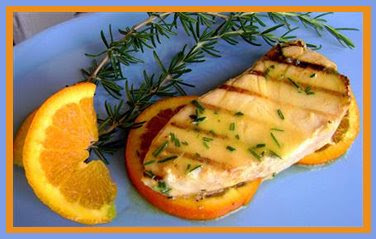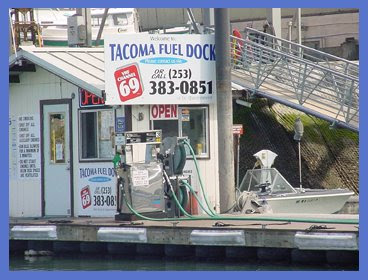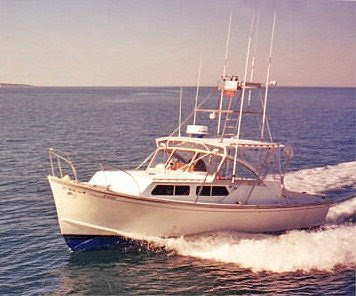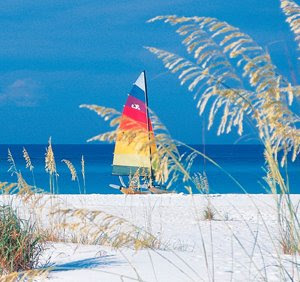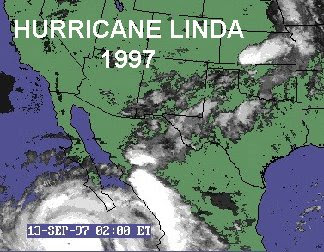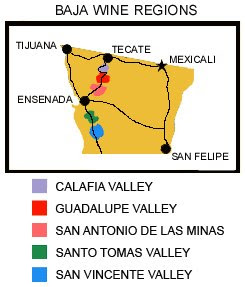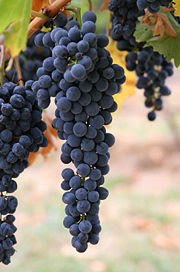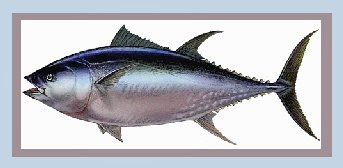
Local to Ensenada and the Coronado Islands True Traveling mariners and road warriors can observe many seaborne circular enclosures which are serving as underwater feedlots for the creatures called "the kings of the sea"; thunnus thynnus orientalis, or Pacific bluefin tuna. These valuable fish are symmetrical, with pointed noses, vacuous eyes, and rigid appendages. This is the fish prized above all others by connoisseurs of sushi and sashimi. The fish whose belly meat (called toro) commands the highest prices on Japanese restaurant menus (with the exception of the potentially poisonous fugu, or blowfish, which is not nearly as widely sold). At its best, when the fat content is high, and the fish has been meticulously handled; the flesh is fabulously tender and buttery, ranging in color from a soft pink to a deep wine red. Obviously too luscious to cook and begging to be eaten raw.
Unlike salmon, tuna has not yet been successfully farmed - that is, raised in captivity from egg to maturity. Currently, all bluefin must be caught in the wild, not only the Pacific species but also its giant, biologically similar Atlantic cousin, which is perhaps slightly less desirable from a gastronomic viewpoint. Around the world, fishermen facing declining quotas for high-quality bluefin tuna are discovering that one way to maximize the return on their reduced catch is to add value to it, only in a novel way; catch them live and fatten them up. That’s what Australian tuna fishermen have done in a big way. Concerned over the sustainability of the species, fisheries managers and the industry established quotas in 1984 to limit the tonnage of fish caught to 14,500 metric tons. That was reduced to 6,250 mt in 1988 and 5,265 mt in 1989.
The notion of capturing gold ingot valued tuna and holding them for the market has been around for a quarter of a century. It started in St Margaret’s Bay, Nova Scotia, in 1976 but stopped a few years later when the giant Atlantic bluefin tuna altered their migration path. Since then, various forms of bluefin aquaculture have been developed, the best known in Port Lincoln, Australia, but with operations spread around the world in Croatia, Malta, Morocco, Spain, Portugal, Japan and Mexico. After entrepreneurs found that the high prices paid for such tuna outweighed the cost of building pens, operations quickly expanded into the Atlantic, to Australia, and then to Baja California. Japan drives the market for fresh fish, it's literally almost a stock exchange. The Japanese auction block determines local tuna prices. After being caught by local seiners, the fish are then transported to farming facilities at the Coronado Islands and the Ensenada area run by Mexican tuna ranchers. Upon arrival at the site, the tuna are herded from the seiners underwater panels into the farm's football field-sized pens, where they are fattened with sardines, anchovies, and other bait fish for three to six months. After months of gorging, the tuna are auctioned at Tsukiji, Tokyo's fish market. Beginning in the 1970s, international fishing laws prohibited Japan from trawling foreign waters in their own boats. Japan had to import, looking to tuna ranches.
The International Union for the Conservation of Nature has listed the bluefin tuna as "critically endangered" on its Red List of species at risk. The number of bluefin tuna has been reduced to less than 5 percent of its original population size in just three decades. Other scientific debates surround the tuna farms and their existence. The Mexican tuna ranchers will do whatever it takes to protect and fatten the “herd”. From the Mexican ecologically forbidden practice of shooting predatory sea lions to spending thousands on temperature-monitoring devices that cool the water so the bluefin build up fat stores and, in turn, fetch a higher price.
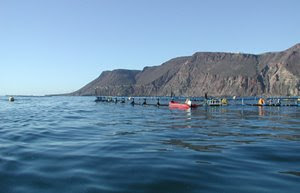
Much of the tuna farm production is delivered to Chesapeake Fish Company at Point Loma Seafoods in San Diego for processing. These companies are involved in all aspects of the seasonal bluefin production, from the killing and cleaning of the fish to the packaging and shipping. Last year the Chesapeake employees worked from August to March to fill a quota of 900 tons of bluefin for Japan.
The bluefin are slaughtered individually by sticking a hook between the eyes that punctures the brain. Attached to the hook is a long pipe that's inserted vertically into the fish. This shocks the spine and speeds up rigor mortis. A tuna's value is determined by its grade. The grade is determined by the fish's color and fat content. Number two grade is more highly valued, as it has more fat content, and number one grade is considered less desirable. There are four grades of tuna; however, most fish buyers recognize only the first two, as number three and number four grades are often either canned or frozen.
Negotiations begin on the dock of San Diego. Buyers from Japan inspect the fish, checking fat content, color, and visual appeal. After calls to Japan to determine current prices, high bids are accepted, and the tuna is submerged in crushed ice -- after being sliced up and boxed for shipment and shipped by Chesapeake's fleet of delivery trucks from the company's Harbor Lane facilities to LAX, where it will go to Tokyo via air freight and be auctioned at Tsukiji, all within 48 hours.
Most of the tuna caught off the coast of California is not bluefin, and only a certain clientele is interested in bluefin, mainly the Asian market. Local fishery officials worry that there is simply not enough room in local Mexican waters for more pens to meet the growing demand. In the Ensenada area, there are six tuna-ranching operations either functioning or approved for operation by the Mexican government. The first and largest of these, Maricultura del Norte, on the south side of Punta Banda, operates 15 pens, and legislation to authorize the first American tuna-ranching operation is being drafted.
With funding from Chevron, Hubbs-Sea World Research Institute of San Diego is seeking permits to operate an experimental fish farm and hatchery for three years at Platform Grace, a relay point along an oil pipeline owned by Santa Barbara oil company Venoco Inc., near Ventura in federal waters. The Grace Mariculture Project would include four submerged pens, encompassing 1H square miles. The project's goal is to help supply a growing demand for seafood. The largest trade deficit in the U.S. is oil, the second is seafood imports. As part of the three-year project, the institute would raise bluefin tuna, California yellowtail, California halibut, striped bass, and red abalone. The Grace Mariculture Project would be used to determine the economic and environmental feasibility of tuna ranching in the U.S. a pilot program to determine just how lucrative commercial bluefin farming is.
A local fishing tournament was affected by the existence of the tuna ranches. On Saturday, Sept. 17, 2005, the Ensenada Club Nautico sponsored the Torneo Internacional De Pesca Deportiva Verano, a huge Baja Norte fishing tournament with over 300 anglers competing in a vastly publicized largest fish contest that was held based in Ensenada. The second place fish, a 64 pound yellowfin tuna was disqualified because it was proven that the angler had bought the tuna from the Salsipuedes pens. Later others commented that the man who submitted the fish had rock cod on his boat and no gear to catch such a fish. The eyes were white and the fish was black and covered in flies. The cheating fisherman got so violent, it was necessary for the police to take him to jail!
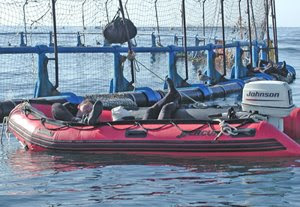
Local boats net the fish, tons at a time, as they cruise along the coast, 20 to 30 miles offshore. Then, the tuna are towed at less than two miles an hour, still in the water in specially designed enclosures, to Puerto Escondido Bay. There they live the life of Riley, splashing happily about in the huge circular pens, gaining weight and building their fat content on a sardine diet - all the fish they can eat, three times every day, six days a week, for four to eight months. To avoid damage to their livers from overeating, the tuna are fed only six days a week. And on those six days, the sardines are broadcast across the surface of the water to force the big fish to compete aggressively for food. Some farmed salmon are criticized because, having no need to work for nourishment, they develop a flabby texture. This method of fattening takes a run-of-the-mill fish, a so-so fish, and transforms it into a superstar, a fish ripe for the markets of the sushi and sashimi connoisseurs of Japan.
The tuna are caught between June and August, as they swim between Magdalena Bay, near the southern tip of Baja California, and Monterey Bay, south of San Francisco. They are sold between October and March, by which time most of the fish weigh up to 190 pounds. Some of the larger tuna in the pens approach 330 pounds.
When the largest local tuna ranch company, Maricultura del Norte gets an order, an appropriate number of fattened tuna are harvested. That gives them an edge over conventional suppliers: they have to sell as soon as their boats dock. They sell when they want to, whether the demand is high or not. At Christmastime, when the demand peaks, Maricultura sometimes harvests as many as 900 tuna in a single day, working from sunrise to sunset. The current price for a gutted bluefin, with head and tail on, runs about $11.50 a pound for small fish, $15.75 a pound for medium fish and even more for larger fish. The meat sells at retail for as much as $45 a pound, despite the lasting slump in the Japanese economy. A 410-pound tuna was sold for a record $160,000 in 2005. Buyers insist on quality - tuna without bruises or blemishes, with vividly colored flesh, with maximum oil and fat content. When the pen is ready to harvest, it is like a ripe fruit, the fish at a perfect point in their development.
The harvesting of the fish is a systematic display of proven methodology. Divers in black wet suits start by raising a barrier inside one of the pens, separating a dozen or so tuna from the rest. Next they grab the fish, one by one, one hand on the tail and the other in the gills, and hoist them onto a barge, where another crew of workers holds them in place. Instantly that team spikes each tuna in the head, killing it, cut a main artery behind the gills to bleed it, and ran a fine steel wire down the fish's spinal column, paralyzing it immediately. Another team, astonishingly deft like the first, then takes over, cutting out the gills and guts in one swift motion and tossing the bluefin into a 32-degree saline water solution. The whole process takes only about 50 seconds. This method is employed to preserve the tuna's quality in two ways: by avoiding the formation of excessive lactic acid and by preventing the fish's blood temperature from rising after it has left the sea. This yields a cut of fish that is blissfully sweet and custard-like, with no hint of the metallic flavor that mars the elderly fare served at second-rate sushi bars.
About 95 percent of Maricultura's output goes to Japan, the other 5 percent is sold in San Diego and Los Angeles, mostly to top restaurants. Chilly from their cold-water bath, the fish are cleaned, weighed, tagged and measured before being placed with cold gel packs in plastic-lined boxes to keep them fresh. If they are harvested on Thursday, for example, they are packed on Friday morning and trucked to Los Angeles International Airport on Friday afternoon. They arrive in Tokyo on Sunday, local time, and go on sale at 5 a.m. Monday. Most of them will be consumed by Wednesday at the latest. That may sound like a very long time. But in fact it is almost ideal; like a number of other fish, such as Dover sole, bluefin only reaches peak flavor and texture four to six days after it has emerged from the water. The Ensenada operations have a marketing advantage over numerous other tuna-penning locations because of its proximity to the Los Angeles airport with its 19 flights a day directly to Tokyo.
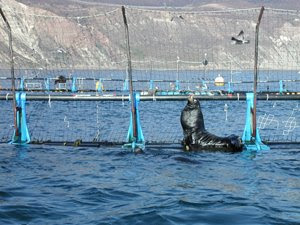
It is the reliability of supply and consistency of quality that make farmed bluefin popular, but they will never replace free-range bluefin in the very top echelon of the market. The true connoisseurs still prefer a wild fish, as they prefer a wild salmon. The muscle and meat structure is not the same from a pen 50 feet across compared to thousands of miles of ocean. Consumers complain about the meat structure and say the fat doesn’t taste right. The wild bluefin still get the top price. When a farmed Australian is going for 3,000 yen per kilo, in the same day a fancy wild bluefin from the East Coast or Spain with good fat will go for 6,000 or 7,000 yen per kilo. It is just a different product; it is not in the same size class, and it is also natural.
Whether tuna farming will serve as a model for farming other species, such as black cod and halibut, remains to be seen; but fishermen in many fleets have a definite success story to ponder as they contemplate the future of their industry. The world's, and especially Japan's, appetite for tuna seems insatiable. The question is whether stocks of bluefin can withstand the pressure. Already, the giant Atlantic bluefin, which can reach up to 1,500 pounds, is listed as endangered by the Monterey Aquarium, which monitors such matters. The southern Pacific bluefin, which is caught off Australia, has also been over fished, but so far the northern Pacific bluefin, caught here, appears to be in better shape.
Many men go fishing all of their lives without knowing that it is not fish they are after.
Henry David Thoreau
 Ever faithful to the cause of fish conservation and ocean awareness, our friend Pablito has again thrown his angler angst into the fray. He reminds you to only catch and keep what you can eat and to always practice the GillBilly creed...
Ever faithful to the cause of fish conservation and ocean awareness, our friend Pablito has again thrown his angler angst into the fray. He reminds you to only catch and keep what you can eat and to always practice the GillBilly creed...


